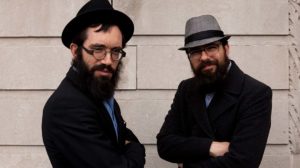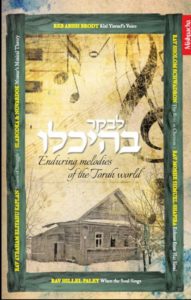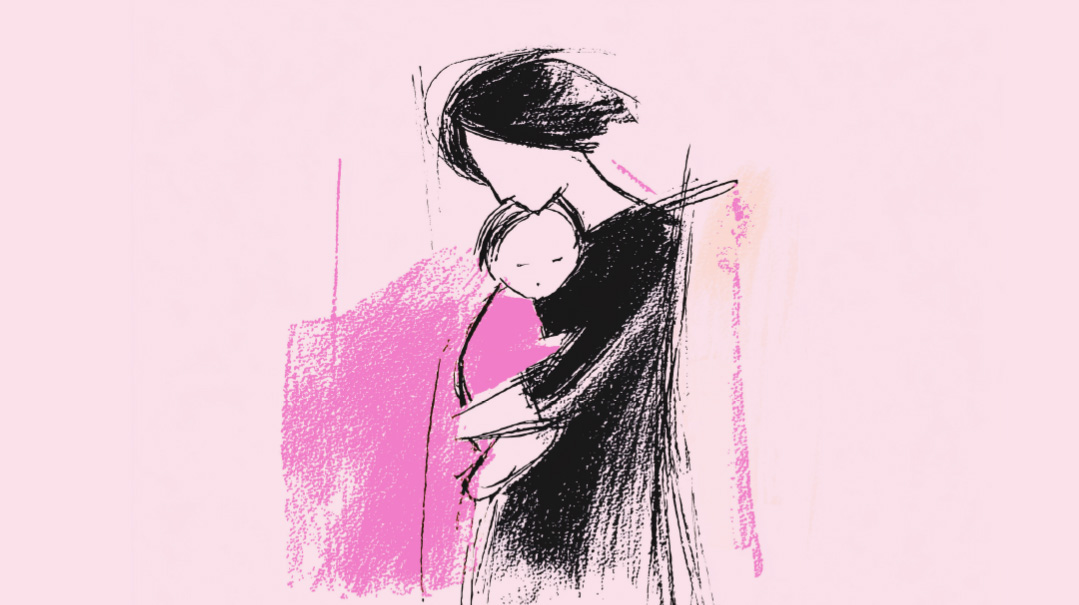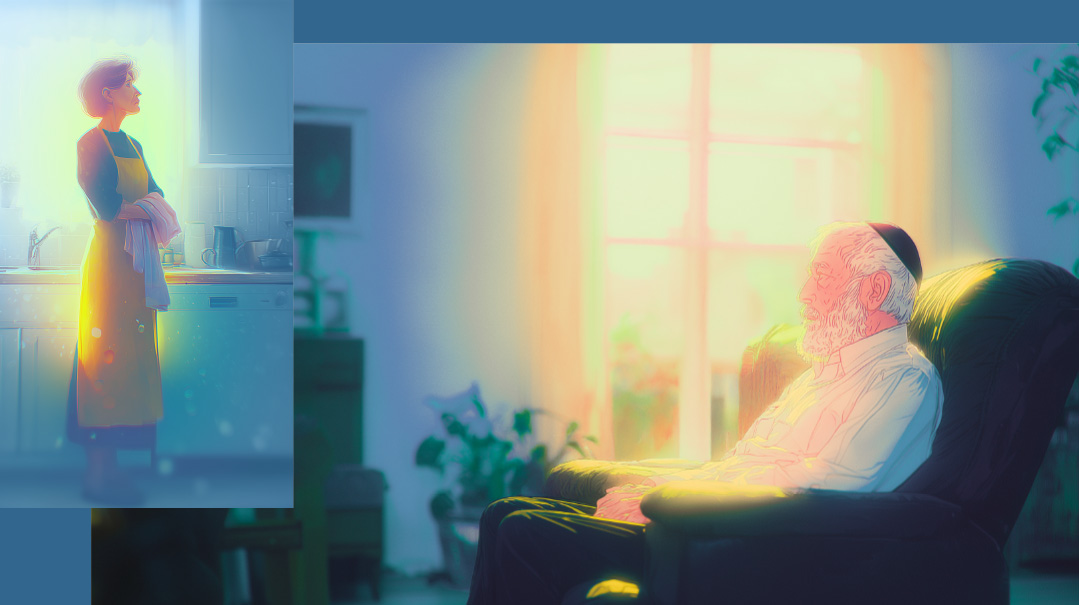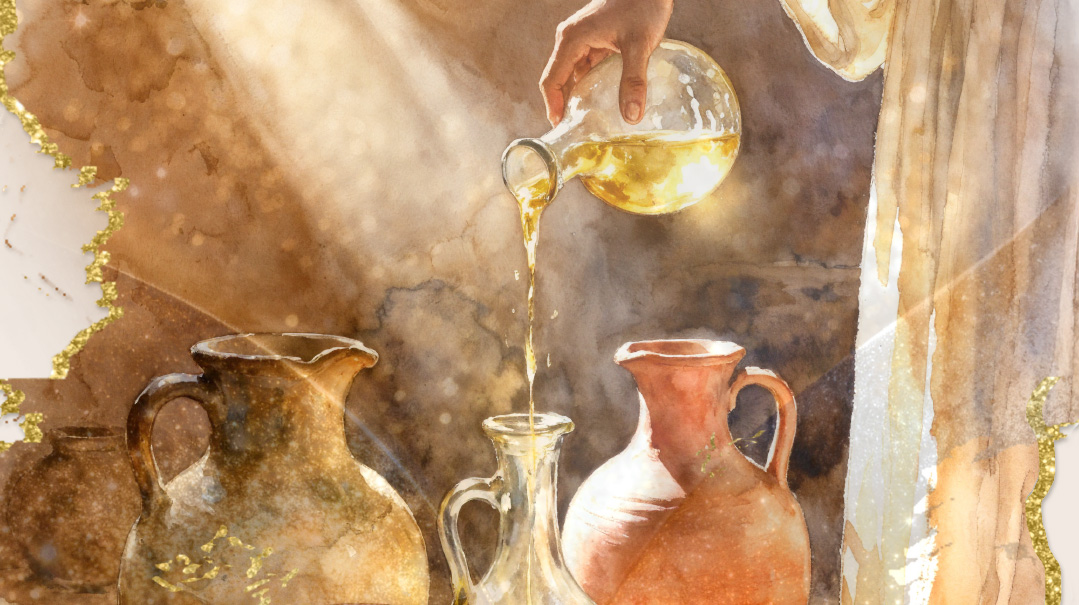Panoramas, Perspectives, and Pesukim
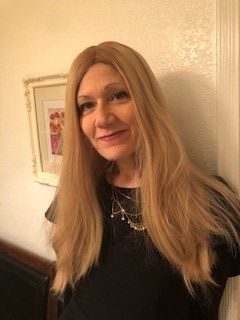
Artist Aliza Marton doesn’t simply paint beautiful scenes; her art incorporates uplifting pesukim, hinting at the spiritual lens through which she views the world
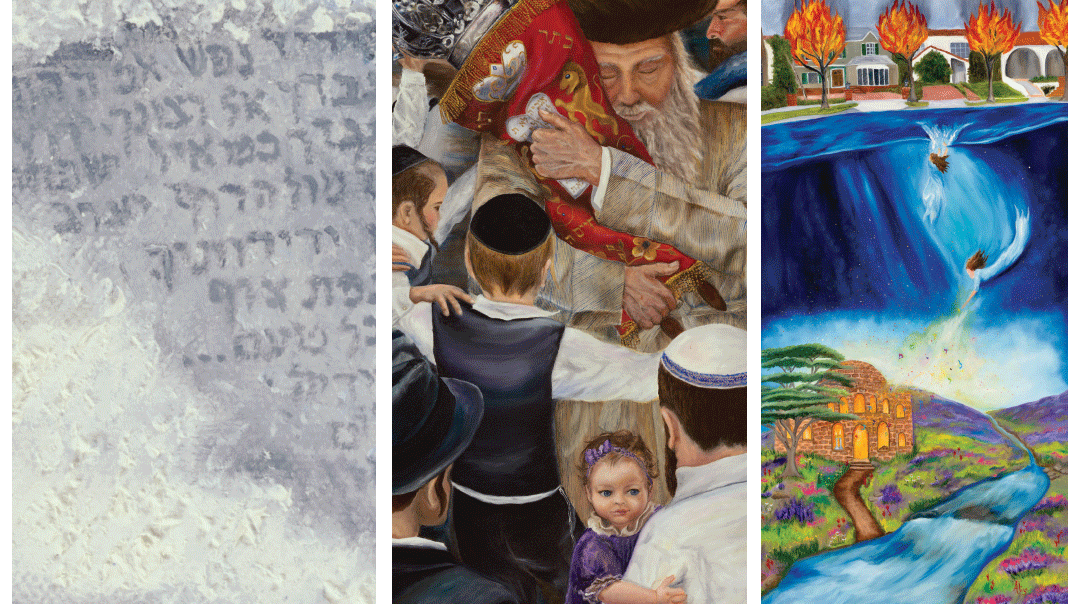
Reminiscent of Nachshon ben Aminadav, when artist Aliza Marton wanted to take a photo for inspiration for one of her paintings, she stepped right into the swirling sea.
The other tourists at Ruby Beach — named for the red ruby-like crystals in the sand — wore wading boots up to their hips and stayed a safe distance from the water’s edge. But upon arriving at the breathtaking beach, a three-hour drive due west from Seattle, Washington, Aliza couldn’t contain her excitement.
Enthralled by the majestic sky, sea, and bluffs, she grabbed her camera and went right into the freezing Hoh River, whose waters receive the icy cold runoff of the melted snow from nearby Mount Olympus.
“I wanted to take pictures, too,” explains Aliza, who lives in Los Angeles. “But I’m a sensory person, so in order to paint a scene, I want to feel it and be a part of it.”
When Aliza’s equally adventurous husband mentioned she might ruin the new hiking boots she’d bought for this trip, which they were taking in honor of their 20th wedding anniversary, Aliza just shrugged, untied her boots, and set off with determination through the water, barefoot, despite the sharp rocks lining the riverbed.
“Are you really going in?” Mr. Marton asked.
“I came here just for this — I’m not going to not go into the water,” Aliza responded with a smile and a giggle as, in her tzniyus clothing and sheitel, she set off for the other side of the river, walking among the bluffs, snapping photos all the way. Her husband soon lost sight of her.
“Was it worth it?” he asked when she returned.
“Absolutely!” she answered, before asking him if they could return to the site the following evening at 10 p.m. for the sunset. She then went on to capture that sunset in a painting. In it, the viewer can see two small figures, Aliza and her husband, walking together in the distance.
When I get together with Aliza, she shows me photos from the many trips she’s taken with her family and alone with her husband. A particularly striking image of Ruby Beach catches my eye. When I ask whether the image was also a photo from her trip, Aliza modestly says, “Thank you for saying that, but that’s the painting I made.”
I gasp and look at the image of Aliza’s Ruby Beach painting again. The scene looks realistic, but upon closer examination, it radiates a life and magic that makes it even more beautiful than a mere photo of the beach.
Artist with a Mission
“Making art that reveals Hashem in everything is my whole purpose!” Aliza says. “Hashem’s not a separate entity in the sky. He’s a living King Who exists within every aspect of our world!”
Aliza articulates the love she feels for Hashem and Torah while creating her artwork by leaving traces of pesukim somewhere in almost every painting. In Ruby Beach, Aliza chose to add these lines from Tefillas Haderech: “May it be Your will, Hashem, our G-d, and the G-d of our forefathers, that You lead us toward peace, direct our steps toward peace, and guide us toward peace…”
Aliza inherited her artistic talent from her parents; her mother is a sculptor and her father is highly skilled at drawing. “My mother often took my siblings and me to visit art museums,” Aliza reminisces. “I remember studying the paintings to determine how the artists achieved different effects.” Even as a little girl, she picked up on the fact that an artist used a tiny dot of white paint to make a piece of fruit look fresh.
Although Aliza didn’t have the opportunity to start painting until age 39, she knew she wanted to paint long before she wrote “artist” as the career to which she most aspired in her eighth-grade yearbook.
As a message to herself, Aliza painted Like Water on a Rock, to remind her that she was not too old to start painting.
“Rabbi Akiva was 40 when he started learning Torah after observing how water slowly wore down and changed a rock,” Aliza explains with a smile. “When I look at this painting, I remind myself that it’s never too late to learn.”
Aliza was first inspired to buy herself a sketchbook and some pencils after a friend remarked how important it was for women to “do nice things for themselves.” Although she briefly enjoyed drawing in her new notebook, her youngest son was then unfortunately involved in a serious accident, which consumed her time and attention for two years.
“Sometimes, when we know clearly what we want to do and that something is important to us, Hashem puts up roadblocks,” Aliza reflects. “Or maybe those obstacles are the yetzer hara trying to hold us back.”
Once her son was healthy and back at school, Aliza decided to join her daughter, then 12 and now herself a mother and an artist, in painting lessons with L.A.-based artist Gila Balsam.
“Gila told me since I was a beginner, I should start with a simple shape, like an apple,” remembers Aliza. “But I wanted to paint the Kosel, something that was really in my heart. Gila was skeptical because of the Kosel’s complexity, and she realistically warned, ‘Okay, as long as you know your painting probably won’t look anything like what you have in mind.’”
When I ask what Gila’s response was to the result, Aliza answers with eidelkeit, “She was fine with whatever I wanted to paint after that.”
It took Aliza an estimated 26 hours to create the many cracks and crevices in the ancient outer wall of the Temple. She now says that is when she formulated her approach to painting. “As an artist, being patient is so much more valuable and fruitful than being a perfectionist,” she says. “Many of us just need to strengthen our patience to sit and develop our talents.”
Aliza felt so much joy at finally getting the opportunity to fulfill her life’s desire to paint that she was inspired to add pesukim to her paintings. She gave the man davening in the painting a siddur that reads “Hodu l’Hashem ki tov, ki l’olam chasdo.”
“I was so grateful to Hashem that I was able to take the time to join a painting class,” says Aliza. She realized she had been putting all of her creativity into her cooking and a popular, dynamic Mommy and Me class that she ran. “Hashem is so good and so giving. I had to express my gratitude. And then every time I made another painting, another pasuk came to mind.”
Bombarded by Beauty
Five years after their Ruby Beach trip, the Martons traveled by air, land, and sea to get to Spire Cove, Alaska, to celebrate their 25th anniversary. “I love the ocean and all the animals and sea creatures in it, and I really wanted to see the whales,” Aliza explains.
They found a location called Humpy Cove in honor of the area’s many humpback and orca whales, around which many vacationers kayak. The Martons stayed in a yurt, a canvas tent without running water. It had a tiny kitchen that featured a little stove, and no fridge — only ice for storing the kosher food she brought.
“There were raspberries and wild blueberries growing in the hills all around us,” Aliza says, and then casually adds that in addition to the beautiful foliage, bears roamed the area.
“We had bear spray,” she says.
Although the Martons were too excited to sleep during their long journey to Spire Cove, as soon as their water taxi arrived, the adventurous couple set off to kayak, explore, and find a waterfall.
“We were so tired, but we pushed ourselves to stay out our first night until 9 p.m.,” says Aliza.
She points out the cute puffins, beautiful rock formations, and resting seals in the photos from which she chooses and juxtaposes images to paint.
Aliza’s enthusiasm for the natural world inspired the pasuk she hid in Spire Cove, “Mah rabu maasecha, Hashem — How amazing are Your creations, Hashem.”
“Nature was all around us. The sun doesn’t go down in Alaska in the summer, and we were having so much fun!” Aliza recalls.
This time, she brought waders to wear under her skirt when she and her husband went fly-fishing. “I really needed to go on that trip,” she says. “As Jewish moms, it’s natural to stay busy with our homes, our children, chesed, and work, but we also need to make time for ourselves and feed our souls.”
Soul Restoration
Aliza also derives inspiration for her paintings closer to home. The moving sight of a Holocaust survivor clutching the Torah to his heart at shul one Simchas Torah inspired her to paint Simchat Torah. “I always love to see the achdus and the mix of different Jews with different hats, kippahs, dress, and minhagim who come to our shul,” she says.
As Aliza watched the elderly man holding on to the Torah so tightly, she could sense some of the horrors he’d been through and that, by clutching the Torah, he was expressing his knowledge that it would restore his soul. The pasuk in this painting is “Toras Hashem temimah, meshivas nafesh.”
When Aliza painted Simchat Torah, she wanted to capture the men and boys’ circular dancing, so she studied the movements of the tiny hummingbirds that flutter around Los Angeles.
Aliza says she chose hummingbirds because their wings flutter so speedily while their bodies appear to remain still.
“I felt if I could capture the blur of the hummingbird’s wings, I could translate that idea into the blur of many men dancing around the Torah,” she explains.
In Simchat Torah, she replicated the hummingbird’s body by keeping the men in the foreground still, but blurring the background, thereby creating the impression that the men were dancing.
In addition to her technical prowess and studying movements and forms in nature, Aliza explains that “by enhancing the colors in the world around me, I attempt to draw out the essence of people and places. To me, color represents hope, freedom, and love of life.”
For instance, she says, leaves’ colors often intensify as they approach the end of their lives and fall from their trees. In her Lotus Flowers painting, she applied that observation by using rich, bright colors to show that the older leaves of the lotus flower “have been through more.” To that painting, she added the pasuk from perek 37 of Tehillim: “I was a youth and also have aged, and I have not seen a righteous man forsaken, with his children begging for bread.”
“Although, in reality, the ‘younger’ lotus flowers were more colorful, I chose to paint them more monochromatically in pinks and grays.” Aliza says this represents the limited perspective and experience of youth. “I added a rainbow of rich, bright, and unexpected colors to the older lotus flowers’ leaves, which in reality appeared duller, because as we age, we become more interesting, wise, and therefore, more beautiful. Just as we see stunning bursts of color when fall leaves begin to wither, I wanted to express that as we learn and gain more experience throughout our lives, we merit to see the world with more depth, variation, and color.”
When I notice a painting of the Steipler Gaon, Rav Yaakov Yisrael Kanievsky ztz”l, staring at me with riveting eyes, I ask Aliza what inspired the painting.
“First, there’s something about his face that really speaks to me,” Aliza responds. “I’m also so moved by how he was true to his beliefs, such as when he was forced to serve in the Russian army. Despite the harsh conditions, the Steipler insisted on observing mitzvos. He wore a summer uniform in the winter to avoid the possibility of shatnez. In addition, as punishment for refusing to violate Shabbos, he was forced to walk through two rows of soldiers, depicted in the distance on the right of the painting, who stood in a ‘gauntlet.’ The soldiers beat him so severely as he passed between them that he lost his hearing in one ear.
“Yet in spite of his hardships, the Steipler always spoke with pride about his time in the Red Army because he considered his ability to stay true to the Torah in such conditions to be his greatest achievement.”
In the painting, in white Hebrew script on light blue snow, Aliza added the pesukim from perek 44 of Tehillim in which Hashem commands the salvation of Yaakov, referencing the Steipler’s first name. She also alludes to the Steipler’s gevurah by continuing with the pasuk, “Our heart has not turned back, neither have our steps declined from Your path.”
Perhaps the Steipler’s story resounds so strongly for Aliza because she’s heard many stories of family members who have been persecuted for their Judaism, all the way back to the Spanish Inquisition.
Inspired by Ladino roots, Aliza chose to be called Nona (Grandma) last year when her first grandson was born in Yerushalayim. After helping and supporting her daughter as she gave birth, Aliza returned to Los Angeles and got right back to painting. When her students and friends eagerly asked to see a picture of the newborn, they were directed not to photos on a phone, but to an easel, where there leaned a still-drying portrait of little Yedidya Shalom.
Although Aliza often sketches her paintings in advance, sometimes she makes decisions as she goes along and observes how a piece turns out. For instance, Aliza wanted to paint Krias Yam Suf not from the usual view on the ground, but from overhead: a bird’s-eye view. “I painted the Yam Suf, and then the horses of the Mitzrim coming after us, and I realized that I liked the painting just as it was, so I left it,” Aliza explains. She added the pasuk from perek 20 of Tehillim: “The Mitzrim slumped and fell, but Hashem invigorated us and saved us.”
As I look at the piece, I realize that the stark and striking images of the horses and the pasuk force the viewer to imagine the next moment, when the Mitzrim and their horses were swallowed up by the Yam Suf as Bnei Yisrael continued on their way on dry land.
Another one of Aliza’s paintings is inspired by a class that she teaches. “I teach a Navi class every week, and we’re coming to the end of Melachim. Speaking about the destruction of the Bais Hamikdash is so sad. Today, we can no longer offer sacrifices to G-d — instead we offer up our prayers.” Aliza’s painting Our Prayers depicts that reality, showing Hebrew letters going up through abstract Jerusalem walls, through the Bais Hamikdash, and rising to the heavens. Aliza admits that she was nervous about the painting. “It’s such a different style than what I normally do,” she says. “Sometimes, you just have to try something new.”
Aliza hasn’t stopped painting since her first class with her daughter. Although she teaches six times a week, five art classes and one Navi shiur, she schedules her own sessions to paint, and often loses track of time in her studio, working there deep into the night.
Now that Aliza’s two daughters are out of the house and many nights her husband and two sons learn late, she stays busy painting her travels, impressions, and dreams, even those she remembers from childhood. Thirteen is a trying age. It was then that Aliza had a dream: “I was running with friends down the street where I grew up. For some reason, each time we passed a tree, that tree independently burst into flames.” Then, the pavement of the L.A. street turned to water, the water that features prominently in so many of her paintings, and Aliza was struggling to stay afloat.
“But once I surrendered and let go,” she explains. “I saw a beautiful world below, full of rich color, life, and holiness.”
In this painting, Aliza represented her passion for the three primary mitzvos for women: Shabbos candles, challah (in the window), and family purity (the stream) by fitting them into the world she discovered in the sea below ground.
Interpreting her dream as an adult, Aliza sees that, despite some challenges (represented by the fires) during her youth, she now realizes that everything was for her benefit and helped her to find the beauty she now sees so effortlessly.
Many Torah sources say that fire is a sign of yearning for closeness to Hashem. The pasuk on this painting expresses Aliza’s signature simchah and bitachon: “Kol d’avid Rachmana l’tav avid. Everything Hashem does is for the good.”
(Originally Featured in Family First, Issue 684)
Oops! We could not locate your form.


